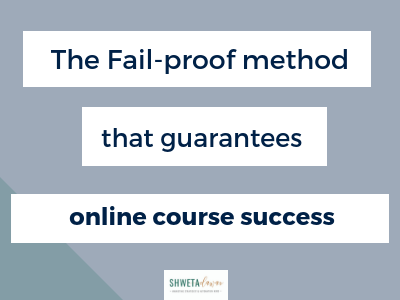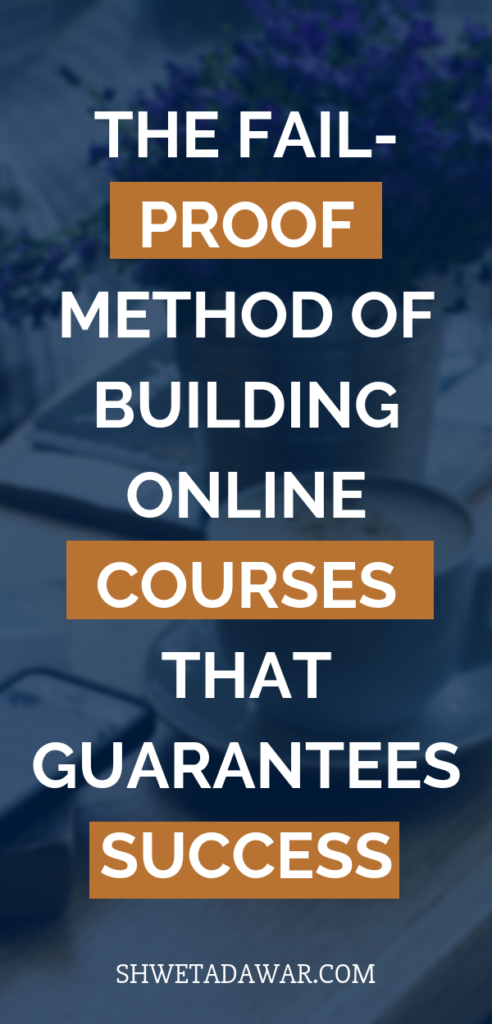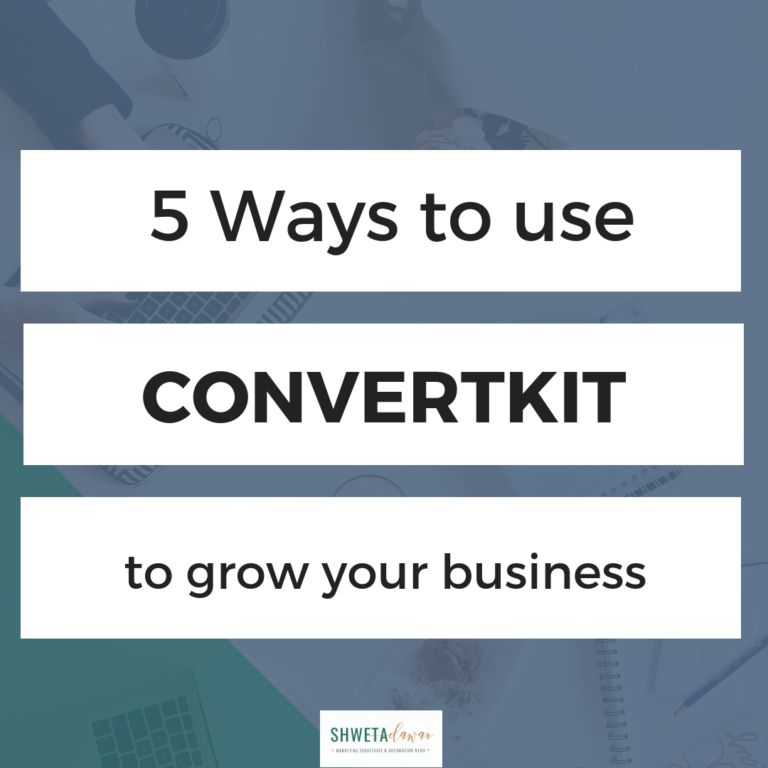Building Online Courses: The Fail-proof method that guarantees course success

A lot of people fail with their online course because they create something that no one really wants, or needs.
They have spent hours of their time and put a ton of effort to create a course that THEY think the world needs, but it doesn’t.
Then when no one buys, they just lose hope and never try again. But, there is a better way.
If you are looking to spend more time this year building online courses, here is a little trick to make sure you are spending your time on things that will matter.
What if you could ask the right questions to your audience and really get to know whether your idea will fly before you spend any effort on it?
The best way to do this is just ask. And asking is the easiest way to validate your idea.
Hint: We are going to spend time on creating the course only after we get paying customers.
We are going to:
→ Validate the idea
→ Beta launch at a low price point
→ Create the course after getting in paid beta testers
→ Improve the course and launch at a higher price point
Let’s look at the step by step break down:
1. Validate your idea
Create a poll on social media, survey your email list, get on the phone with your ideal audience and ask them questions.
If you find that no one is really interested in the idea or they think they will not benefit from it, burn that idea.
If you do see some interest, it is time to go to the next step.
You could also create a survey with open ended questions so that you not only end up validating your idea, but also get help with creating an outline based on what your audience spoke about in the survey.
2. Decide the format and length of your course
Once you have validated your idea and you know there is a market for your course, you will need to decide what format you are going to create in course it. You will also need to decide whether you want this course to be small and specific or full blown, in detail.
This will depend on your audience and how they learn best.
Do you think a masterclass would help them, or maybe you think you might need to create in depth videos for the topic you are about to teach?
This is a great article on how to choose the format of your online course.
3. Decide the tech and tools you will use:
Once you have decided on the format of your course, it is take a decision about the tools you will be using. Since we don’t want to be spending too much money for the beta-launch, I would suggest you to use what is already available.
Create an opt-in page on your website, use free tools to create a lead magnet, and use a Facebook group to host your beta- course.
Once you get paid members, you can then invest in tools like Clickfunnels, Teachable etc.
4. Create an outline
Once you have validated your idea and decided on the format and length, you will need to create a course outline.
Think about the different subtopics you will cover within your course.
Are you teaching a particular skill or are you going teach them to do something in a better way?
You can also use a tool like coggle.it to create a mindmap of all the different things you want to cover as part of this course.
Here is a little trick, go on amazon, search for a well reviewed book related to your course idea and use the look inside button to preview the contents of this book.
This will give you ideas as to what you can include in the course.
Convertkit writes about creating a course outline in this article.
5. Reverse engineer to create a lead magnet
Once that is done, this is whether you actually start building out your funnel. Although you are still going to launch this course in the beta-version, you want to make sure that you create a lead magnet that is relevant to the course. This lead magnet will help you get people into your funnel.
The best way to create a lead magnet for your beta-launch would be to give a small part of your course away for free. This will also give your audience a sneak peek into your course, and help them decide whether it is something they want to buy.
RELATED: How to create a lead magnet in 100 minutes

6. Promote a lead magnet to get beta testers
Once you have your lead magnet created and designed, it is time to start promoting it to your audience.
Reach out to people who you know will benefit from this topic and invite them to opt-in for your lead magnet.
Share you lead magnet inside your community.
Share your lead magnet in other Facebook groups and get people to sign up.
Although this is a beta-launch, not really a full-fledged launch, we want to reach as many people we can and get them on our list.
Be sure to promote your lead magnet for at least 2 weeks to get enough people to sign up.
P.S. This depends on your audience size. If you have a big audience already, ( 1000 subscribers), all you will need to do is send 4-5 emails and you will get enough beta-testers.
The lead magnet should include details of your paid product. Since this is a beta- product, your price point will be much lower than the actual cost.
You will want to make it very clear to your audience that this is a beta-launch and the course will be created as you go. You also want to mention that you are open to feedback from your audience in order to make the course valuable to them.
7. Create your course , one module a week
Now that you have 10 beta-testers in your course, it is time to actually create the content of your course.
Since during the sales process, you mentioned about this being a beta-launch, your paid customers already know that you are going to be creating the course as you go.
You can create a schedule to create the course content, either a module a week or whatever else suits you, depending on your schedule.
The great thing about using this process is that you already of sales, and therefore an incentive to actually create the course.
8. Live Q and A sessions
You can have a Facebook group to host your course and conduct live Q and A sessions.
The big advantage of the beta-launch and creating a course as you go is that you get to ask your students for feedback so you can create a better course that will really help your students.
This strategy also helps to get testimonials before you actually have a big launch for the course.
9. Improve your course based on feedback
Now that you have created the course and gotten feedback from your students, it is time to improve the course based on feedback.
You might also want to polish your videos and invest in a hosting platform to create a smooth process for your students to access the course.
Depending on feedback, you might want to add or delete certain trainings from your course.
You can also give an opportunity to your beta-testers to become affiliates for your course launch.
My experience:
My first attempt at building online courses was in my 7th month of business. I had been providing messenger bot services to coaches, consultants and online service providers. I had realized that there was a need for a course that would teach them the same thing, but at a lower price point.
Facebook messenger bots were new, and I wasn’t sure how many people would actually buy the course.
I knew my idea was validated because I already had clients who wanted me to build chatbots for them, but I also wanted to make sure that people would pay for such a course.
RELATED : How I launched a minimum viable product with a $0 investment
Once I knew my course idea was validated, I went on to step 2.
I decided that I wanted to use videos for this course, since I would be teaching all the tech related to bots.
I also decided loosely on the outline because even though I wanted to have a structure, I wanted the course to be open to adjustments based on the feedback I would receive during the beta- phase.
I then created an outline for the course based on my work with my clients and the questions I had received related to bots.
I can reverse engineered and decided to use a mini introductory bots course as a lead magnet.
I also decided to run this course through the bot itself, so that my audience could experience the use of bots.
My lead magnet was a 5 day mini course on how to get started with Facebook messenger bots. You can check it out here.
I also created the landing page for this lead magnet using a messenger bot software, Manychat.
In the 5th video of this free mini course, I introduced my paid course and mentioned about the beta-launch. I also stated that my course was being offered at a huge discount as part of the beta launch, that is, only for $47.
My goal was to get 10 people inside the beta launch and make some money even before I started creating my paid course.
Promotion:
Once my lead magnet was ready, I promoted in within my small community as well as in other Facebook groups.
I also collaborated with some past clients and promoted it to their community.
By the end of 2 weeks, I had 10 people signed up for my beta-launch, giving me a good indication that there was a market for this product.
Once I had 10 people, I started creating the course live.
I had Q and A sessions and live bot building sessions inside the Facebook group.
I then improved my course based on feedback and 6 months later, I relaunched it for $497.
Update: I am working on splitting up the course into a basic and advanced version to help more people implement bots in their business. I am also going to be including a module on how to sell bots as a service if you are a digital marketer or a virtual assistant.
Have you launched an online course yet, or planning to? Let me know in the comments below.





